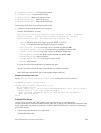
ipv6 ospf process-id area area-id
– process-id: the process ID number assigned.
– area-id: the area ID for this interface.
Assigning OSPFv3 Process ID and Router ID Globally
To assign, disable, or reset OSPFv3 globally, use the following commands.
• Enable the OSPFv3 process globally and enter OSPFv3 mode.
CONFIGURATION mode
ipv6 router ospf {process ID}
The range is from 0 to 65535.
• Assign the router ID for this OSPFv3 process.
CONF-IPV6-ROUTER-OSPF mode
router-id {number}
– number: the IPv4 address.
The format is A.B.C.D.
NOTE: Enter the router-id for an OSPFv3 router as an IPv4 IP address.
• Disable OSPF.
CONFIGURATION mode
no ipv6 router ospf process-id
• Reset the OSPFv3 process.
EXEC Privilege mode
clear ipv6 ospf process
Enter an example that illustrates the current task (optional).
Enter the tasks the user should do after finishing this task (optional).
Configuring Stub Areas
To configure IPv6 stub areas, use the following command.
• Configure the area as a stub area.
CONF-IPV6-ROUTER-OSPF mode
area area-id stub [no-summary]
– no-summary: use these keywords to prevent transmission in to the area of summary ASBR LSAs.
– Area ID: a number or IP address assigned when creating the area. You can represent the area ID
as a number from 0 to 65536 if you assign a dotted decimal format rather than an IP address.
Configuring Passive-Interface
To suppress the interface’s participation on an OSPFv3 interface, use the following command.
This command stops the router from sending updates on that interface.
648
Open Shortest Path First (OSPFv2 and OSPFv3)


















